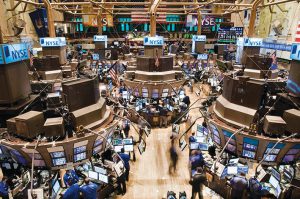BLOOMBERG
US equity futures climbed on investor bets that a peak in interest rates is near and bank turmoil will ease further. European stocks rose and the dollar declined in the risk-on mood.
S&P 500 contracts and those on the tech-heavy Nasdaq 100 advanced at least 0.5% after an earlier rally that pushed the latter into a bull market. Retail shares led gains as the Stoxx Europe 600 Index rose to a three-week high, with Hennes & Mauritz AB soaring the most since June 2001 after the Swedish clothing company’s results beat expectations.
Stocks have been drifting higher in recent days as the worst of the bank selloff recedes, even with a lack of fresh news on the direction of interest rates. Attention in the US turns next to jobless claims data and the core personal consumption expenditure reading for insights on the Federal Reserve’s policy moves. Investors now expect US rates to sit around 4.3% by the end of the year, around 70 basis points lower than the current level.
“Market sentiment remains relatively positive, and investor confidence remains high despite the recent turmoil brought by the financial sector, as appetite for risk gets supported by the prospect of dovish pivots from central banks, providing a good excuse to push stock indices higher just before the end of the quarter,†said Pierre Veyret, a technical analyst at ActivTrades.
The current rally is built more on expectations than actions, leaving the market vulnerable should central banks — especially the Fed — disappoint investors, Veyret added.
Treasury yields were steady, following muted trading on March 29 when the 10-year benchmark moved by the smallest margin in more than a month. The greenback weakened against most of its Group-of-10 peers.
In the trading, the Nasdaq 100 rose 1.9%, which cemented its 20% rebound from a low in December. The gauge, which includes Apple Inc, Microsoft Corp, and Amazon.com, closed at the highest level since August in a sign investors are preparing for the Fed to end its interest rate hiking cycle and potentially pivot to looser policy later this year.
On the European economic front, Spanish inflation plummeted as energy costs retreated, though persistent underlying price pressures underscored the dilemma for the ECB as it weighs how much to raise interest rates. March’s headline reading came in at 3.1% — down from February’s 6% and much lower than the 3.7% median estimate in a Bloomberg survey of economists.
Core inflation, however — which excludes volatile items like fuel and fresh produce — only dipped a touch, to 7.5%. Policy sensitive German two-year bonds fell as much as 14 basis points, while money markets lowered bets on the peak ECB rate to 3.40% from 3.49%.
Elsewhere in markets, oil rebounded after its first drop in three sessions as dollar weakened and. Gold steadied and Bitcoin rose, trading above $28,000.
Meanwhile, expectations of an easing in central-bank policy and the potential of a recession see global stocks and bonds moving more closely in line with each other than they have in nearly three decades, providing a headache for fund managers seeking to spread their risk.
The rolling one-year correlation between the asset classes is near its highest since 1997, according to data compiled by Bloomberg. The narrowing difference in performance makes it “tricky to diversify equity exposure,†Sanford C Bernstein strategists Sarah McCarthy and Mark Diver wrote in a note.
The Bloomberg Dollar Spot Index fell 0.3% and the euro rose 0.3% to $1.0878. While the British pound rose 0.2% to $1.2338, the Japanese yen rose 0.2% to 132.54 per dollar.
 The Gulf Time Newspaper One of the finest business newspapers in the UAE brought to you by our professional writers and editors.
The Gulf Time Newspaper One of the finest business newspapers in the UAE brought to you by our professional writers and editors.
